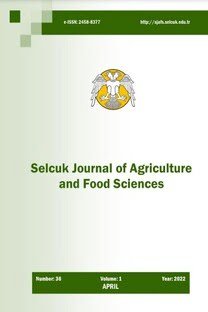Physical properties and nutrient contents of three edible summer squash (Cucurbita pepo L.) Varieties seeds
besin maddesi içeriği, fiziksel özellikler, kabak, tohum, Cucurbita pepo
Bazı yazlı kabak tohumlarının fiziksel özellikleri ve besin içerikleri
nutrient content, physical properties, squashes, seeds, Cucurbita pepo,
___
- 1. Anoniymous (2003). Available _____http//www. herb data Pumpkin seeds, pepitas, squash seeds.htm>
- 2. AOAC (1990). Official methods of analysis (17th ed.). Washington,DC: Association of Official Analytical Chemists.
- 3. Aydin, C, Öğüt, H. (1992). Determination of deformation energy in some biological materials. National Symposium on Mechanisation in Agriculture, Samsun, Turkey (pp. 254-264).
- 4. Carman, K. (1996). Some physical properties of lentil seeds. Journal of Agricultural Engineering Research 63, 87-92.
- 5 .Deshpande, S. D., Bal,.S., Ojha, T. P. (1993). Physical properties of soybean. Journal of Agricultural Engineering Research 56, 89-98.
- 6. Ekinci, S. (1972). Özel Sebzecilik. Ahmet Sait Matbaası. İstanbul.
- 7. Gupta, R. K., Das, S. K. (1997). Physical properties of sunflower seeds.Journal of Agricultural Engineering Research 66,1-8.
- 8. Joshi, D. C, Das, S. K., Mukherjee, R. K. (1993). Physical properties of pumpkin seeds. Journal of Agricultural Engineering Research 54, 219-229.
- 9. Mohsenin, N. N. (1970). Physical properties of plant and animal materials. New York: Gordon and Breach Science Publishers.
- 10.Nyomora, A.M.S., Sah, R. N., Brown, P.H. (1997).Boron determination in biological materials by inductively coupled plasma atomic emission and mass spectrometry: effect of sample dissolution methods. Fresenius J. Anal Chem. 357, 1185-1191.
- 11.Öğüt, H. (1998). Some physical properties of white lupin. Journal of Agricultural Engineering Research 56,273-277.
- 12.Paksoy, M., Aydın, C. (2004). Some physical properties of edible squash (Cucurbita pepo L) seeds.Journal of Food Engineering 65, 225-231.
- 13.Sitkei, G. (1986). Mechanics of agricultural materials. Budapest: Akademiai Kiado.
- 14.SSI (2003). Agricultural statistics. Ankara, Turkey.
- 15.USDA (1970). Official grain standards of the United States. US Department of Agricultural Consumer and Marketing Service Grain Division, Revised.
- 16.Vural, H., Eşiyok, D, Duman, İ. (2000). Kültür Sebzeleri (Sebze Yetiştirme). Egean University Pres Bornova, İzmir, Turkey
- ISSN: 1300-5774
- Yayın Aralığı: 3
- Başlangıç: 2018
- Yayıncı: Selçuk Üniv. Ziraat Fak.
Bor biriktiren Gypsoplila I., Cinsi bitkilerin moleküler genetik yöntemlerle karakterizasyonu
Erdoğan Eşref HAKKI, Ayşegül ÜNLÜ, Zeynep ÖZBEK, Sait GEZGİN, Mehmet BABAOĞLU
AHMET ÜNVER, Mehmet Musa ÖZCAN
Konya ili ilçesi tarım arazileri için kapitalizasyon oranının tespiti
Combining abilities for grain yield and leaf characters in pea parents and crosses
Konya ilinde fasulye tarımında karşılaşılan problemler ve çözüm önerileri
Birol ÖZKALP, Mustafa Onur ALADAĞLI, Battal ÇELİK
Kentsel arıtma çamuru ve azot uygulamalarının kireçli topraklarda bazı toprak özelliklerine etkileri
Mısır makarnası kalitesine bazı katkıların ve hamur ön pişirme metotlarının etkisi
